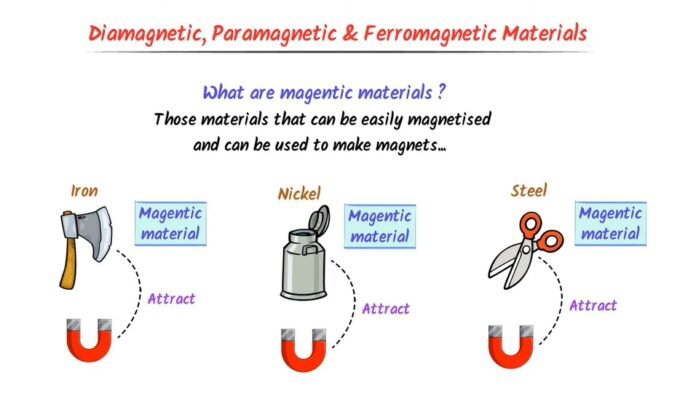A magnetic material is a material that can be magnetized and has the ability to produce a magnetic field. There are several types of magnetic materials including diamagnetic, paramagnetic, and ferromagnetic materials.
Diamagnetic materials are weakly repelled by a magnetic field and have no unpaired electrons, making them unable to be magnetized.
Paramagnetic materials are weakly attracted to a magnetic field and have a small number of unpaired electrons, which allow them to be weakly magnetized.
Ferromagnetic materials are strongly attracted to a magnetic field and have many unpaired electrons.
Magnetic Susceptibility
Magnetic susceptibility measure the magnetic response of a material in a magnetic field. It is defined as the ratio of magnetization to the applied magnetizing field intensity. The magnetic susceptibility can be either positive or negative, depending on the type of material.
Positive magnetic susceptibility indicates that the material is paramagnetic or ferromagnetic, meaning that it is attracted to a magnetic field. The higher the magnetic susceptibility, the stronger the material’s magnetic response.
Negative magnetic susceptibility indicates that the material is diamagnetic, meaning that it is weakly repelled by a magnetic field.
Diamagnetic Substance
A diamagnetic substance is a material that is weakly repelled by a magnetic field . Diamagnetic substances are not magnetized and have no magnetic moments.
Examples of diamagnetic substances include copper, gold, and silver. These materials have all electrons paired in their atomic structure and therefore have no net magnetic moment.
Diamagnetic substances are also characterized by having a negative magnetic susceptibility, meaning that they are weakly repelled by a magnetic field.
Characteristics of Diamagnetic Substance
Diamagnetic substances have the following characteristics:
Weakly repelled by magnetic fields: Diamagnetic substances are weakly repelled by magnetic fields and have no magnetic moments.
Negative magnetic susceptibility: Diamagnetic substances have a negative magnetic susceptibility, meaning that they are weakly repelled by a magnetic field.
Non-magnetic: Diamagnetic substances cannot be magnetized and have no magnetic properties.
Poor conductors of electricity: Most diamagnetic substances are poor conductors of electricity, making them useful as insulators.
Examples: Examples of diamagnetic substances include copper, gold, silver, bismuth, and lead. These materials are commonly used in various applications due to their diamagnetic properties.
Paramagnetic Substance
Paramagnetic substances are materials that have a weak magnetic moment and are attracted to a magnetic field.
Examples of paramagnetic substances include aluminum, platinum, and oxygen.
Characteristics of Paramagnetic Substance
The characteristics of paramagnetic substances are:
Weak magnetic moment: Paramagnetic substances have a weak magnetic moment and are only weakly attracted to magnetic fields.
Attraction to magnetic fields: Despite their weak magnetic moment, paramagnetic substances are attracted to magnetic fields.
Low magnetic susceptibility: Paramagnetic substances have a low magnetic susceptibility, meaning they do not easily become magnetized.
Ferromagnetic Substance
Ferromagnetic substance is a type of magnetic material that exhibits strong, persistent magnetization even in the absence of an external magnetic field. The magnetic domains of a ferromagnetic material are aligned in the same direction, giving it a strong net magnetic moment.
Examples of ferromagnetic materials include iron, nickel, cobalt, and their alloys.
Characteristics of Ferromagnetic Substance
Ferromagnetic substances exhibit the following characteristics:
Strong magnetic behavior: Ferromagnetic substances have a strong magnetic field and are easily magnetized.
Large magnetic susceptibility: Ferromagnetic substances have a large and positive magnetic susceptibility,
Persistence of magnetization: The magnetization of a ferromagnetic material remains even in the absence of an external magnetic field, unlike diamagnetic or paramagnetic substances.
Properties of Diamagnetic Paramagnetic and Ferromagnetic Substance
| Properties | Diamagnetic | Paramagnetic | Ferromagnetic |
|---|---|---|---|
| Effect of magnetic field | Weakly repelled by a magnetic field | Weakly attracted to a magnetic field | Strongly attracted to a magnetic field
|
| Magnetic susceptibility | Small and Negative | Small and Positive | Large and Positive |
| Relative Permeability | Less than unity | Greater than unity | Very large |
| Example | Copper,Gold,Silver | Aluminium,Platinum | Iron,Cobalt |
Types of Magnet
There are several types of magnets:
Permanent magnets:
These magnets retain their magnetic properties permanently and do not require an external magnetic field to maintain their magnetization. Examples include neodymium, samarium-cobalt, and alnico.
Electromagnets:
These magnets are created by passing an electric current through a coil of wire, creating a magnetic field. The strength of the magnetic field can be controlled by adjusting the current.
Temporary magnets:
These magnets lose their magnetic properties when the magnetic field is removed. Examples include iron, cobalt, and nickel.
Recommended Articles:
Determine Mass Of Two Different Objects By Using A Beam Balance
Determine Resistance Plotting Graph Potential Difference Versus Current
Deuterium: Introduction, Properties, Uses, And Facts
Detergents And Surface Tension
Deuteron Mass: Introduction, Measured, Importance, Properties And Significance
Those substance which have tendency to move from strong to weak part of external magnetic field.They have small and negative magnetic susceptibility . Ferromagnetic materials, such as iron, are often used as cores for electromagnets. They are used in the construction of electric motors and generators. Magnetism is a phenomenon by which materials exhibit attractive or repulsive forces. Ans. Some example of Paramagnetic and Diamagnetic substances are given as- Paramagnetic Substance - Aluminium,Platinum Diamagnetic Substance - Copper,Gold,Silve Diamagnetic Paramagnetic And Ferromagnetic FAQs
What is Diamagnetic Substance?
Write the application of Ferromagnetic substance?
Define Magnetism?
Write the example of Paramagnetic and Diamagnetic substances?
